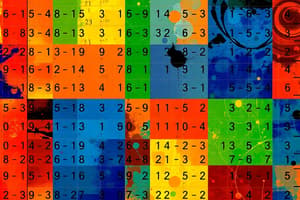Podcast
Questions and Answers
What value of $ heta$ will lead to a unique solution for the system of equations: $ heta x + 2y - 2z = 1$, $4x + heta y - z = 2$, $6x + 6y + z = 3$?
What value of $ heta$ will lead to a unique solution for the system of equations: $ heta x + 2y - 2z = 1$, $4x + heta y - z = 2$, $6x + 6y + z = 3$?
- $ heta = 4$ (correct)
- $ heta = 2$
- $ heta = 6$
- $ heta = 0$
Which of the following represents the necessary condition for $
rac{
rac{ ext{partial}^{2}f}{ ext{partial }x^{2}} +
rac{ ext{partial}^{2}f}{ ext{partial }y^{2}} = 0$ for $f(x, y) = ext{log} ext{sqrt}(x^{2} + y^{2})$ to hold?
Which of the following represents the necessary condition for $ rac{ rac{ ext{partial}^{2}f}{ ext{partial }x^{2}} + rac{ ext{partial}^{2}f}{ ext{partial }y^{2}} = 0$ for $f(x, y) = ext{log} ext{sqrt}(x^{2} + y^{2})$ to hold?
- The partial derivatives must be constant.
- The function must be linear.
- The function is not defined at the origin.
- The partial derivatives must be continuous. (correct)
For the function $f(x,y) =
rac{xy(x^{2} - y^{2})}{x^{2} + y^{2}}$ when checking the limit as $(x,y) o (0,0)$, which limit approach is crucial?
For the function $f(x,y) = rac{xy(x^{2} - y^{2})}{x^{2} + y^{2}}$ when checking the limit as $(x,y) o (0,0)$, which limit approach is crucial?
- Approaching along any linear path. (correct)
- Approaching along the x-axis only.
- Approaching along the y-axis only.
- Approaching at equal rates in x and y.
What is the geometric multiplicity of an eigenvalue if the associated modal matrix does not have enough linearly independent eigenvectors?
What is the geometric multiplicity of an eigenvalue if the associated modal matrix does not have enough linearly independent eigenvectors?
Which of the following indicates that the system of equations is consistent: $x_1 + 2x_2 + x_3 = 2$, $2x_1 + 4x_2 + 2x_3 = 4$, $3x_1 + x_2 - 2x_3 = 1$, $4x_1 - 3x_2 - x_3 = 3$?
Which of the following indicates that the system of equations is consistent: $x_1 + 2x_2 + x_3 = 2$, $2x_1 + 4x_2 + 2x_3 = 4$, $3x_1 + x_2 - 2x_3 = 1$, $4x_1 - 3x_2 - x_3 = 3$?
Flashcards
Eigenvalues and Eigenvectors
Eigenvalues and Eigenvectors
Eigenvalues are the scalars that, when multiplied by a vector, result in a vector that points in the same direction.
Unique solution for equations
Unique solution for equations
A system of linear equations has a unique solution when the determinant of the matrix formed by the coefficients is not zero.
Partial Derivatives of f(x,y)
Partial Derivatives of f(x,y)
The rate of change of a function f with respect to one variable at a time, while holding others constant.
Continuity
Continuity
Signup and view all the flashcards
Gauss elimination method
Gauss elimination method
Signup and view all the flashcards
Study Notes
Q3 - Attempt Any Two Questions
-
Question 1: Find the value of λ such that the system of equations Ax + 2y - 2z = 1, 4x + λy - z = 2, 6x + 6y + λz = 3 has a unique solution.
-
Question 2: Prove that the function f(x, y) = log√(x² + y²) satisfies the given equation.
-
Question 3: Examine if the limit lim (x,y)→(0,0) (x³y-y⁴)/(x⁴+y⁴) exists for x ≠ 0, y ≠ 0.
Q4 - Compulsory
-
Part A:
- A square matrix A is defined by A = [4 1] [2 3]
- Find the modal matrix P and the resulting diagonal matrix D of A.
- Determine the algebraic and geometric multiplicities of the eigenvalues.
-
Part B:
- OR: Check if the following system of equations is consistent using Gaussian elimination:
- x₁ + 2x₂ + x₃ = 2
- 2x₁ + 4x₂ + 2x₃ = 4
- 3x₁ + x₂ - 2x₃ = 1
- 4x₁ - 3x₂ - x₃ = 3
- OR: Test the continuity of f(x, y) = {(xy(x²-y²))/(x²+y²), when x ≠ 0, y ≠ 0} {0, when x = 0, y = 0}
- OR: Check if the following system of equations is consistent using Gaussian elimination:
Studying That Suits You
Use AI to generate personalized quizzes and flashcards to suit your learning preferences.




